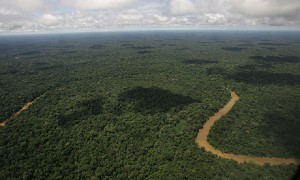1. ECUADOR: Extraordinary Biodiversity of the Yasuní National Park
The Yasuní National Park in Ecuador is the most biodiverse zone of South America and one of the most biodiverse in the world, according to a report by Ecuadorian and U.S. scientists published in the open-access online scientific journal PLoS ONE (plosone.org).
This park is threatened by oil exploration. In January Ecuadorian President Rafael Correa announced that he would authorize the installation of oil wells in Yasuní despite his earlier promise to seek economic compensation for his country in exchange for leaving the national park intact.
“Yasuní is at the center of a small zone where South American’s amphibians, birds, mammals, and vascular plants all reach maximum diversity,” reported Dr. Clinton Jenkins of the University of Maryland. “The 150 species of amphibians documented to date in Yasuní is a world record for an area of this size,” said Diego F. Cisneros Heredia, of Universidad San Francisco of Quito. “There are more species of frogs and toads within Yasuní than there are native to the United States and Canada combined.”
“In just one hectare in Yasuní, there are more species of trees, bushes, and lianas [woody vines] than in anyplace in the world,” said Ecuadorian botanist Gorky Villa, who has worked with the Smithsonian Institution and the non-governmental organization Finding Species.
It is estimated that in a single hectare of the Yasuní forest, there are 100,000 species of insects. According to the distinguished entomologist Terry Erwin, this is the highest biodiversity per unit area in the world for any plant or animal group. The authors of the study found that Yasuní is home to at least 121 reptile species, 596 bird, 382 fish, and 204 mammal species.
“Yasuní is probably unmatched by any other park in the world for total numbers of species,” according to Margo Bass, principal author of the article who works for Finding Species.
Throughout the campaign on behalf of Yasuní, President Correa has repeatedly labeled the ecologists as “infantile” and “fundamentalist.” On occasions he has singled out the organization Acción Ecológica and its spokesperson Esperanza Martínez in these attacks.
“I belong to a predominantly women’s organization, in which we place a higher value on ethical conduct and courage in speaking out than on submission and subordination,” Martínez declared in a letter to Correa dated Jan. 27.
“The enigma, Mr. President, has yet to be resolved. Why are environmental issues being polarized, particularly those related to the initiative to leave crude oil underground? Who is doing the polarizing and what interests are behind them? What led to the absurd announcement that environmentalists are the worst enemies of change? There are those who probably will interpret that to mean that the right is no longer the enemy, but environmentalists and indigenous groups are.”
SOURCES:
Matt Finer (Save America’s Forests)
http://www.biodiversidadla.org/content/view/full/54325
Esperanza Martínez, Open letter to president Correa, Jan. 27, 2010
http://www.biodiversidadla.org/content/view/full/54496
2. BRAZIL: Controversial Hydroelectric Plant on the Madeira River
The beautiful Madeira River.
Tractebel Energy, a subsidiary of the French transnational GDF Suez, is involved in the construction of a controversial hydroelectric project on Madeira River in Brazil that has been repudiated by communities and environmental organizations in Peru, Bolivia, and Brazil. The Madeira, which is among the 10 longest and mightiest rivers in the world, is the main tributary of the Amazon River. Its basin, which spans 1.42 million square kilometers in three countries, is twice as large as that of the Mississippi River.
“The massive project is designed to make the Madeira River navigable along a 4,200-kilometer waterway,” the German group Rainforest Rescue (Salva la Selva) reported. “Two additional dams upriver will facilitate the transport of enormous amounts of raw materials such as soy, timber, and minerals from the interior of the country to Atlantic and Pacific ports for export. The project is the heart of the destructive Initiative for the Integration of South American Infrastructure (IIRSA).”
Rainforest Rescue warns that the environmental damage resulting from this project will be disastrous. “In the Madeira River there are 750 species of fish and birds. The construction of the hydroelectric dam will modify to a great extent the migratory routes of the fish. The tropical rainforest, including protected areas, will be flooded. In 2007, the announcement of the project alone led to massive deforestation in the Brazilian state of Rondonia. Area inhabitants will also be gravely affected. Three thousand people will be relocated and traditional zones for the collection of rubber, nuts, and other forest products will be flooded by the dam.”
Rainforest Rescue initiated a petition campaign and sent a letter addressed to the French government, which owns 36% of GDF Suez stock, to stop the hydroelectric project.
For more information: http://www.salvalaselva.org/protestaktion.php?id=511.
3. BRAZIL: Obama, Biofuels, and Sugarcane Plantations
Obama said that biofuels were the road
to energy independence.
President Barack Obama’s State of the Union address on Jan. 27 had Brazilians jumping for joy, according to activist Eric Holt-Gimenez, director of the non-governmental organization Food First.
In his address, Obama said that biofuels were the road to “energy independence while building a foundation for a new clean energy economy, and its promise of new industries and millions of jobs.” Then, on Feb. 3, UNICA, the Brazilian Sugarcane Industry, cheered when the U.S. Environmental Protection Agency (EPA) announced that ethanol derived from sugarcane emits 50% less hothouse gas than gasoline.
Holt-Gimenez explains that the United States cannot rely on domestic corn production for ethanol. “Even if we planted the entire U.S. corn crop for ethanol, we would only substitute 12% of our gasoline use.” Therefore, he says, Obama’s words about biofuels and the EPA declaration about sugarcane ethanol mean that the United States will open its doors to massive imports of Brazilian ethanol; the vast majority of jobs created in this “new clean energy economy” will be in Brazil.
In any case, the “ethanol boom” won’t create many jobs, since refining corn or sugarcane to produce ethanol is a high-tech process that that doesn’t require much labor. Moreover, the process is controlled at the international level by a small handful of companies, among them Archer Daniels Midland, Shell, and the Brazilian corporate giant COSAN.
It remains an open question whether the U.S. president’s support for biofuels is really a victory for Brazil, since foreign transnationals exercise growing control over its sugarcane industry. In 2008 the U.S.-based Monsanto, the largest seed and agricultural biotech company in the world, bought from the Brazilian conglomerate Votorantim its Canavialis and Allelyx subsidiaries, both of them the most advanced companies in the world in sugarcane genetics and genomics. Monsanto is now intent on developing genetically engineered Roundup Ready sugarcane.
Environment 360, Yale University’s online environmental bulletin, published data on Brazilian sugarcane ethanol from Professors David Pimentel and Ted Patzek of Cornell and the University of California, respectively. Here are some of their findings:
* Sugarcane ethanol does not substitute fossil fuels—each hectare planted with sugarcane uses up 393 kilograms of fossil fuel.
* 12 to 14 kilograms of sugarcane are required to produce a single liter of ethanol.
* 7,000 liters of water are required to produce a liter of ethanol.
* 10 liters of wastewater are produced with every liter of ethanol.
* 31 tons of soil are lost to erosion from every hectare planted with sugar cane.
SOURCES:
http://www.huffingtonpost.com/eric-holt-gimenez/the-biofuels-bailout-meth_b_449277.html
Carl Zimmer, “The High-tech Search for a Cleaner Biofuel Alternative,” Environment 360, Jan. 5, 2009, http://www.e360.yale.edu/content/feature.msp?id=2106.
4. BIOTECHNOLOGY: More Genetically Modified Crops Means More Toxic Agrochemicals
Toxic agrochemicals represent
a serious danger.
Biotech companies assure that their genetically modified (GM) crops are good for the environment because they require fewer toxic agrochemicals, such as insecticides and herbicides. But a recently published study by scientist Charles Benbrook demonstrates the opposite. The study was based on data from 13 years of cultivation of genetically modified corn, soybeans, and cotton in the United States. In 2009 Brazilian health officials and the government of Uruguay also presented data that showed that the introduction of GM crops was accompanied by a sharp increase in the use of toxic agrochemicals.
“This is serious because agrochemicals are an important factor in environmental damage (to water, subsoil, flora, and fauna) and human health,” stated Silvia Ribeiro, of the non-governmental organization ETC Group. Many agrochemicals “are endocrine disruptors (they produce hormonal disequilibrium, resulting in diminishing fertility) and/or affect the nervous and immune systems, among other problems. It’s been proven that because of the enormous amount of toxic agrochemicals used in their cultivation, GM foods contain residual levels of toxic agrochemicals that are up to 200 times higher than those that are non-GM.” [Parenthesis in original.]
The agrochemical most utilized on GM crops is Roundup, the Monsanto herbicide whose active ingredient is glyphosate. The company maintains that its use is environmentally beneficial since it’s less toxic than other herbicides.
“Glyphosate, which companies used to describe as innocuous—although that was never true and Monsanto was fined for deceptive advertising—was considered less toxic than other herbicides,” says Ribeiro. “In fact, thanks to GM crops, the concentration of glyphosate has increased exponentially and [Benbrook’s] report found that in certain cases, more than 100 times the amount per unit area was used than occurs with other herbicides. Ultimately, they have an even greater impact than herbicides that are classified as more dangerous. Moreover, companies increase the percentage of the active component in the formulas and they add surfactants [surface active agents] and other substances to aid the action of glyphosate, all of which increases the impact.”
The Argentine embryologist Andres Carrasco, lead researcher on the National Council of Scientific and Technical Researchers (Conicet) and director of the Laboratory of Molecular Embryology at the University of Buenos Aires, investigated the effects of glyphosate on embryos and found substantial adverse effects. He reported on his findings in 2009. As a result, biotechnology advocates subjected him to a prolonged attack campaign. “Anonymous threats, attacks in the media, and political pressures were some of the consequences of a double sin—investigating the health effects produced by the agricultural model and, what was even more serious, going public with the information,” the Argentine daily Pagina 12 reported.
Ribeiro warned that because weeds are becoming resistant to Roundup, companies are now developing new GM seeds that may cause even more problems.
“Companies ‘face’ the problem of resistance with more of the same: they create new genetically modified seeds with even more foreign genes to resist simultaneous applications of various agrochemicals …. Gene stacking is very lucrative: seeds cost up to three times what conventional seeds cost. But the risk of environmental contamination, contamination of the genetic makeup, the risks to the consumer, are all multiplied by the presence of new elements, as well as by the negative synergy they create among themselves. One of the worst examples of this is Monsanto’s SmartStax corn, with eight novel genes inserted into its DNA. A case was filed in Canada because the health impacts were not evaluated. Nevertheless, [Mexican officials] irresponsibly approved it for consumption in Mexico.”
SOURCES:
Darío Ananda, Andrés Carrasco interview, Página 12, May 3 2009, http://www.pagina12.com.ar/diario/elpais/1-124288-2009-05-03.html.
Silvia Ribeiro, “Transgénicos usan más tóxicos,” La Jornada, Jan. 30, 2010, http://www.biodiversidadla.org/content/view/full/54438.
Carmelo Ruiz Marrero is an independent environmental journalist and environmental analyst for the Americas Program (americasprogram.org), a fellow at the Oakland Institute and a senior fellow at the Environmental Leadership Program, as well as founder and director of the Biosafety Project of Puerto Rico (bioseguridad.blogspot.com). His bilingual web page (carmeloruiz.blogspot.com) is devoted to global environmental and development issues.
Translated for the Americas Program by Barbara Belejack.
For More Information
Biodiversity Report CIP Americas Program, January 2010
http://americas.irc-online.org/am/6678
Biodiversity Report CIP Americas Program, December 2009
http://americas.irc-online.org/am/6659
Biodiversity Report CIP Americas Program, November 2009
http://americas.irc-online.org/am/6584




